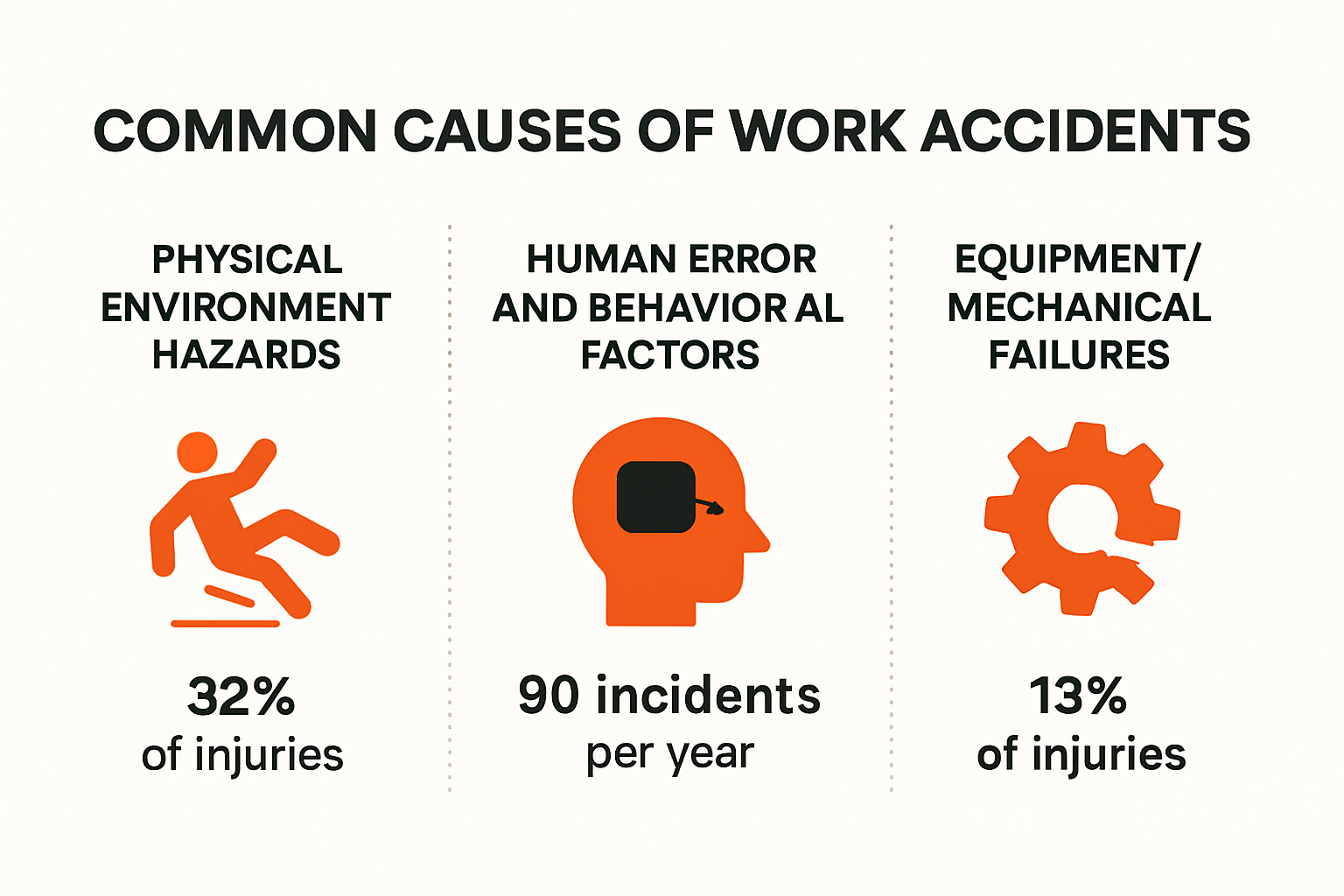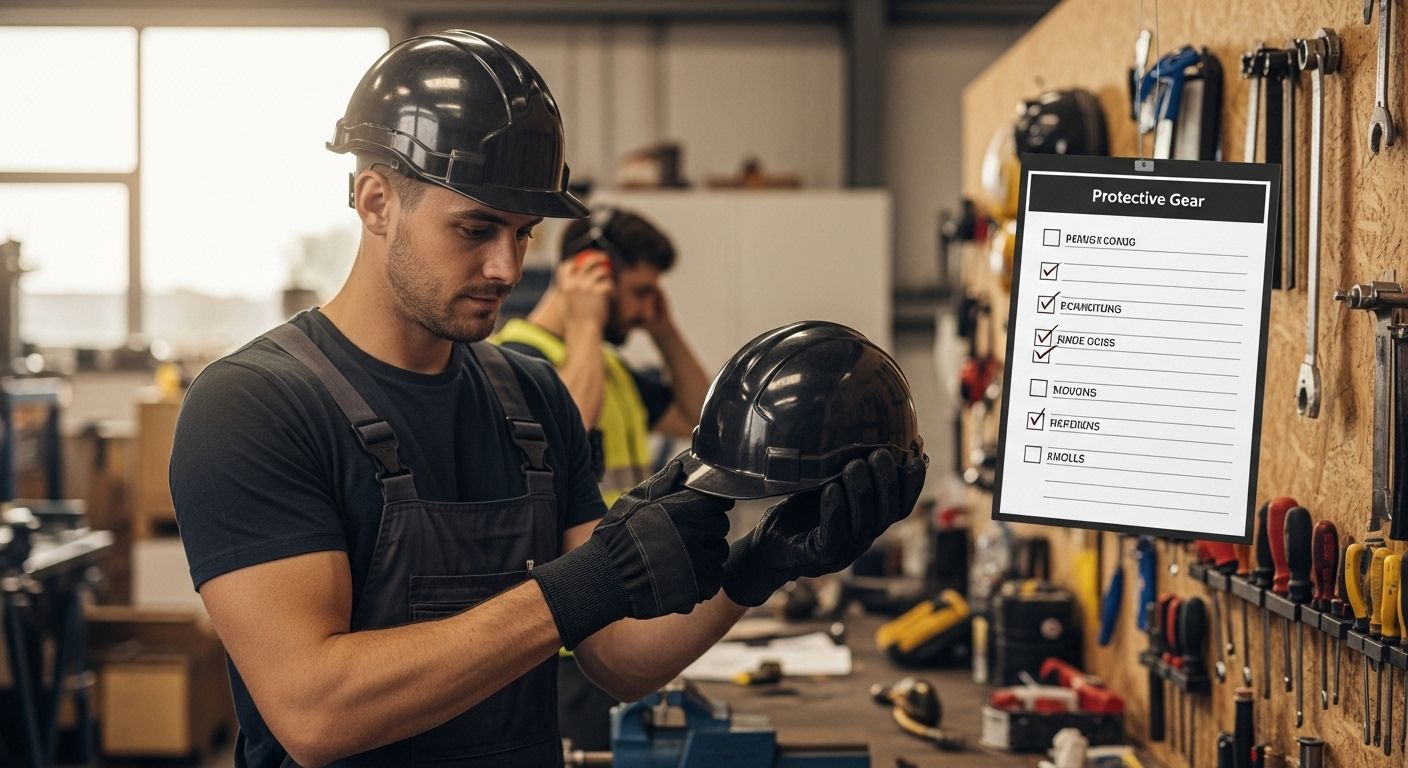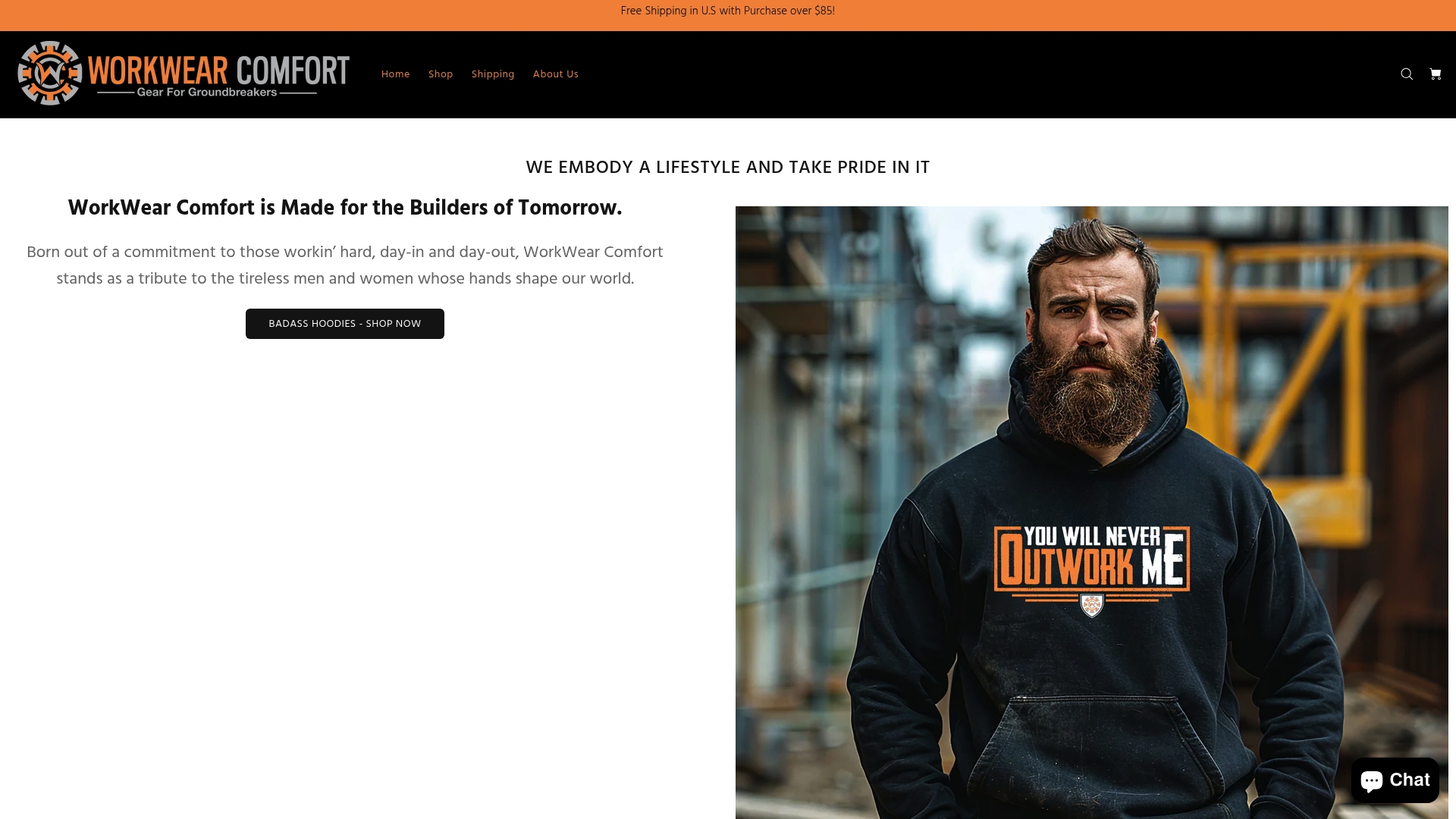Work accidents can strike anywhere, from busy construction sites to calm office environments. Here is a shocker. Slips, trips, and falls make up a huge portion of workplace injuries, sending over 200,000 American workers to the emergency room every year. Most people think these injuries just come with risky jobs or bad luck. In reality, most accidents are preventable with the right habits, the right gear, and a little bit of knowledge you probably have not heard before.
Table of Contents
- Common Causes of Work Accidents on the Job
- Steps to Take Immediately After a Work Accident
- Essential Protective Gear for High-Risk Jobs
- Preventing Work Accidents: Safety Tips for Tradespeople
Quick Summary
| Takeaway | Explanation |
|---|---|
| Identify and Address Work Hazards | Regularly inspect the work environment for physical hazards to prevent accidents. Ensure walkways are clear and equipment is properly maintained. |
| Document Accidents Immediately | Thoroughly documenting any work accident is essential for legal and compensation purposes. Collect evidence and witness accounts promptly while details are fresh. |
| Wear Appropriate Protective Gear | Use personal protective equipment (PPE) suited for your specific job risks to minimize injury. Regularly inspect and maintain this gear for effectiveness. |
| Report Incidents to Employers Promptly | Quickly report any accidents to your employer to comply with workplace protocols and secure your rights regarding compensation claims. |
| Engage in Continuous Safety Training | Regular training and skill enhancement are crucial for reducing workplace incidents. Participate in workshops and practical safety sessions to remain informed. |
Common Causes of Work Accidents on the Job
Workplace accidents are complex events with multiple potential triggers that can dramatically impact worker safety and organizational productivity. According to the U.S. Bureau of Labor Statistics, understanding these common causes is crucial for developing effective prevention strategies.
Physical Environment Hazards
The physical workspace presents numerous potential risks for work accidents. Uneven surfaces, inadequate lighting, cluttered walkways, and improper equipment placement can transform an ordinary worksite into a potential danger zone. Slips, trips, and falls represent a significant portion of workplace incidents, often resulting from wet floors, unrepaired flooring, or obstructed pathways. Construction sites, manufacturing facilities, and warehouses are particularly vulnerable to these environmental challenges.
Workers in industrial settings face additional risks from machinery and equipment. Poorly maintained machines, lack of proper safety guards, and inadequate training can lead to catastrophic accidents. Moving parts, electrical systems, and heavy machinery create inherent risks that require constant vigilance and comprehensive safety protocols.
Human Error and Behavioral Factors
Human behavior plays a critical role in workplace safety. Fatigue, distraction, overconfidence, and inadequate training contribute significantly to work accidents. Research from the National Safety Council highlights that many workplace incidents stem from preventable human errors.
Factors such as rushing through tasks, ignoring safety procedures, improper use of personal protective equipment, and failure to follow established protocols can dramatically increase accident risks. Workplace culture also plays a crucial role - environments that prioritize speed over safety or discourage reporting of potential hazards create conditions ripe for potential incidents.
Equipment and Mechanical Failures
Mechanical failures and equipment malfunctions represent another significant source of workplace accidents. Aging infrastructure, lack of regular maintenance, and improper equipment usage can lead to unexpected breakdowns and potential injuries. Electrical systems, heavy machinery, and complex industrial equipment require consistent inspection and maintenance to minimize accident risks.
Proper training, regular equipment checks, and a robust safety management system are essential in mitigating these risks. Workers must be empowered with knowledge about potential hazards and equipped with the necessary skills to recognize and respond to potential equipment failures.
By understanding these common causes, organizations can develop comprehensive safety strategies that protect workers and minimize the potential for work accidents. Prevention requires a multifaceted approach that addresses environmental, human, and mechanical factors with equal attention and commitment.
To help you quickly understand the different types of workplace hazards, the table below summarizes the key causes of work accidents mentioned in the article along with their typical examples and risk factors.
| Cause of Work Accident | Typical Examples | Main Risk Factors |
|---|---|---|
| Physical Environment Hazards | Wet floors, poor lighting, cluttered walkways, machinery | Uneven surfaces, obstructed paths, improper equipment setup |
| Human Error / Behavioral Factors | Rushing, distraction, ignoring PPE use, poor training | Fatigue, overconfidence, weak safety culture |
| Equipment/Mechanical Failures | Malfunctioning machinery, breakdowns | Aging equipment, lack of maintenance, improper usage |

Steps to Take Immediately After a Work Accident
A work accident can be a disorienting and stressful experience, but taking the right steps immediately after an incident can protect your health, legal rights, and potential compensation. According to the Norwood Young America Area Chamber of Commerce, having a clear action plan is crucial for managing workplace injuries effectively.
Ensure Immediate Safety and Medical Attention
The first and most critical priority is personal safety. If the accident occurs in a hazardous area, move to a safe location immediately. Assess yourself for injuries and call emergency services if the situation appears serious. Even seemingly minor injuries can have significant underlying complications, so seeking prompt medical evaluation is essential.
The Lawrence Berkeley National Laboratory’s Environment, Health, and Safety Manual emphasizes the importance of reporting injuries to Health Services during business hours or through designated off-hours contact numbers. A professional medical assessment creates an official record of the injury and ensures proper treatment.
Document the Accident Thoroughly
Detailed documentation is crucial for potential workers’ compensation claims and legal protection. Immediately after ensuring your safety, begin collecting evidence. Take photographs of the accident scene, your injuries, and any equipment or environmental factors that might have contributed to the incident. If possible, gather contact information from witnesses who can provide statements about what occurred.
Write a comprehensive, factual account of the accident while the details are fresh in your memory. Include specific information such as the time, location, circumstances leading to the incident, and any potential witnesses. This documentation can be vital for insurance claims, workplace investigations, and potential legal proceedings.
Report the Incident to Your Employer
Notifying your employer about the work accident is a critical step that must be done promptly and officially. Contact your direct supervisor or the designated workplace safety officer to report the incident in writing. Provide a detailed account of what happened, including the date, time, location, and nature of the injuries.
Request a copy of the official accident report and ensure it accurately reflects your experience. Many workplaces have specific protocols for reporting workplace accidents, so familiarize yourself with these procedures beforehand. Keep copies of all communications and reports for your personal records.
Remember that timely reporting protects your rights and helps establish a clear timeline of events. Most workers’ compensation claims have strict deadlines, so acting quickly is essential to preserving your ability to seek compensation for medical expenses and potential lost wages.
By following these steps, you can effectively manage the aftermath of a work accident, protect your health, and ensure you have the necessary documentation to support any potential claims or legal actions. Stay calm, methodical, and prioritize your safety and well-being throughout the process.
The following table breaks down the critical steps to take immediately after a work accident, summarizing the purpose and actions involved at each stage.
| Step | Purpose | Key Actions |
|---|---|---|
| Ensure Immediate Safety & Medical Care | Protect health & prevent further injury | Move to safe area, assess injuries, seek medical attention |
| Document the Accident | Secure evidence for legal & compensation needs | Take photos, collect witness info, write detailed incident account |
| Report Incident to Employer | Meet legal/workplace reporting requirements | Notify supervisor, file written report, keep all documentation |
Essential Protective Gear for High-Risk Jobs
Personal protective equipment (PPE) serves as the first line of defense in preventing workplace injuries across high-risk professional environments. Our guide on professional workwear highlights the critical importance of selecting appropriate protective gear tailored to specific job requirements.
Head and Face Protection
According to the Occupational Safety and Health Administration, head protection is fundamental in environments with falling object risks. Hard hats designed to absorb impact and resist penetration are essential for construction workers, industrial laborers, and electrical technicians. These protective helmets must meet specific safety standards and be regularly inspected for structural integrity.
Face protection extends beyond hard hats. Safety glasses, face shields, and specialized masks protect workers from flying debris, chemical splashes, and potential respiratory hazards. Different professional settings demand unique face protection strategies - welders require specific tinted shields, while laboratory workers need splash-resistant transparent shields.
Body and Extremity Protection
The Centers for Disease Control and Prevention emphasizes the importance of comprehensive body protection. Protective clothing ranges from flame-resistant coveralls in industrial settings to chemical-resistant suits in laboratory environments. Gloves represent a critical component of extremity protection, with materials specifically engineered for different workplace challenges.
For electricians and technicians, insulated gloves provide critical protection against electrical hazards. Construction workers require cut-resistant hand protection, while medical professionals need disposable gloves capable of preventing pathogen transmission. The selection of appropriate hand protection directly correlates with reducing workplace injury risks.
Respiratory and Hearing Protection
The U.S. Environmental Protection Agency categorizes respiratory protection into multiple levels based on potential environmental hazards. Respirators range from simple dust masks to complex self-contained breathing apparatus used in highly contaminated environments. Proper fit testing and training are crucial for ensuring respiratory protection effectiveness.
Hearing protection represents another critical safety consideration. In environments with persistent loud noise - such as construction sites, manufacturing facilities, and aerospace industries - earplugs and earmuffs become essential. These protective devices help prevent long-term hearing damage by reducing decibel exposure.
Choosing the right protective gear requires understanding specific workplace risks, maintaining equipment properly, and receiving comprehensive training on correct usage. Workers must recognize that PPE is not just a regulatory requirement but a fundamental aspect of personal safety and professional responsibility. Regular equipment inspection, replacement of worn items, and staying updated on the latest safety technologies are key to maintaining optimal workplace protection.
The table below summarizes types of essential protective gear required for high-risk jobs, their main purpose, and typical examples mentioned in the article.
| Type of Protection | Main Purpose | Typical Examples |
|---|---|---|
| Head and Face Protection | Prevent head injuries, block debris/splashes | Hard hats, face shields, safety glasses, masks |
| Body & Extremity Protection | Protect body & limbs from hazards | Flame-resistant suits, gloves (insulated, cut-resistant) |
| Respiratory & Hearing Protection | Prevent inhalation of hazards & hearing loss | Respirators, earplugs, earmuffs |

Preventing Work Accidents: Safety Tips for Tradespeople
Tradespeople face unique workplace challenges that require proactive safety strategies and continuous awareness. Our guide for top trades gear emphasizes that prevention starts with understanding potential risks and implementing comprehensive safety protocols.
Workplace Awareness and Risk Assessment
According to the National Institute for Occupational Safety and Health, developing a robust safety mindset is critical for preventing workplace accidents. Tradespeople must consistently evaluate their work environment, identifying potential hazards before beginning any task. This involves conducting thorough pre-work inspections, checking equipment integrity, and understanding the specific risks associated with each job.
Effective risk assessment involves more than visual inspection. Workers should systematically analyze potential interaction points between themselves, equipment, and the surrounding environment. This means understanding machine operation zones, identifying potential fall risks, and recognizing electrical, chemical, or mechanical hazards that might not be immediately apparent.
Training and Continuous Education
Comprehensive safety training goes beyond initial job orientation. Successful accident prevention requires ongoing education and skill development. Regular safety workshops, equipment handling courses, and emergency response training can significantly reduce workplace incident rates. Tradespeople should actively seek opportunities to enhance their safety knowledge, staying updated on the latest protective techniques and technological advancements.
Effective training programs should incorporate hands-on demonstrations, scenario-based learning, and interactive sessions that allow workers to practice critical safety skills. This approach transforms theoretical knowledge into practical, actionable safety strategies that workers can implement immediately in their daily tasks.
Equipment Maintenance and Personal Responsibility
Proper equipment maintenance is a shared responsibility between employers and employees. Tradespeople must consistently inspect their tools, protective gear, and work environments for potential issues. This includes checking electrical cords for fraying, ensuring machinery guards are intact, and verifying that personal protective equipment meets current safety standards.
Personal responsibility extends beyond individual actions. Creating a culture of safety means communicating potential risks to colleagues, reporting near-miss incidents, and actively participating in workplace safety discussions. Workers should feel empowered to pause work if they identify an unsafe condition and have clear protocols for reporting and addressing potential hazards.
Preventing work accidents requires a holistic approach that combines individual awareness, comprehensive training, and organizational commitment to safety. Tradespeople who prioritize continuous learning, maintain their equipment, and foster a proactive safety culture can significantly reduce their risk of workplace incidents. Remember that safety is not just a set of rules but a dynamic, ongoing process that requires constant attention and dedication.
Frequently Asked Questions
What are the common causes of work accidents?
Work accidents often arise from physical environment hazards like wet floors and uneven surfaces, human error including distractions and fatigue, and equipment or mechanical failures such as inadequate maintenance or malfunctioning machinery.
How should I document a work accident?
To document a work accident effectively, take photographs of the scene and your injuries, collect contact information from witnesses, and write a detailed account of the incident while the details are fresh in your memory. Include specifics like time, location, and circumstances surrounding the accident.
What protective gear is essential for high-risk jobs?
Essential protective gear includes head protection like hard hats, body protection such as flame-resistant clothing and suitable gloves for extremities, as well as respiratory and hearing protection like respirators and earplugs, tailored to specific job requirements.
What steps should I take immediately after a work accident?
Immediately after a work accident, ensure your safety and seek medical attention if necessary. Document the accident thoroughly and report the incident to your employer in writing, keeping copies of all communications for your records.
Gear Up for Safety and Confidence at Work
You face real risks on the job every day, from unexpected slips and equipment failures to the constant need for protective gear you can truly rely on. As our “Work Accident Guide” shows, avoiding injuries is not just about policies. It is about being prepared, checking your environment, and wearing workwear that stands up to tough conditions and supports your safety goals.

Why settle for clothing that cannot keep up with the demands of your trade? At WorkwearComfort.com, you will find durable apparel with features that help you stay safe and look sharp. Explore solutions like UPF 50+ hoodies, flexible pants built for rugged environments, or women’s workwear designed for confidence and visibility. Investing in quality workwear is a smart way to prevent accidents and protect your livelihood—especially when mistakes can change everything. Visit WorkwearComfort.com now to find gear that meets your needs and get ahead of workplace hazards today.
Recommended
- Best Workwear for Electricians: Top Choices for 2025 - WorkWear Comfort
- What Is Workwear? A 2025 Guide for Hardworking Professionals - WorkWear Comfort
- Best Workwear for Hot Weather: Stay Cool & Protected in 2025 - WorkWear Comfort
- Best Affordable Workwear Brands for Tough Jobs 2025 - WorkWear Comfort
- What Is Accident Coverage? Essential Guide for World Travellers - Unparalleled Global Benefits
- Disability Discrimination Workplace: What You Need To Know


